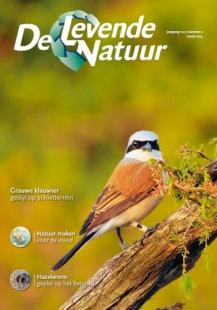De Levende Natuur nummer 2 van 2021 (English summary)
Afbeelding

A trait-based approach to nature conservation and biodiversity
Esther Beukhof, Karen van de Wolfshaar, Ingrid Tulp & Ulrika Beier
Monitoring programmes that sample organisms on a regular basis provide information on changes in population abundances, as well as on species leaving or entering an area. Considering climate change, such changes already have occurred and are expected to occur in the future. It is therefore important to understand the consequences of such changes for ecosystems and the functions and services they provide. A promising approach is not to look at species per se, but at the traits that these species carry – in ecology called the trait-based approach. Traits can tell us about the functional role of species within an ecosystem or food web, and how sensitive species are to environmental change or human disturbance. Within marine policy, traits are already successfully applied to monitor the health of marine food webs and to study the influence of fisheries on the seafloor. Furthermore, traits can be used to identify the importance of species for ecosystem functioning and transform current nature policies by not only protecting species but also ecosystem functions. Similarly, biodiversity policies may benefit from monitoring the diversity of species, as well as the diversity of traits and functions. The trait-based approach thus provides indicators and tools to move towards a truly ecosystem-based management.
Slow worms Anguis fragilis on bicycle paths
Rob G. Bijlsma
The number of slow worms killed on two bicycle paths in a nature reserve in the northern Netherlands increased in 1990-2020 concomitant with the number of cyclists, approximately doubling with each doubling of cyclists. Out of 163 slow worms recorded on bicycle paths, 135 (83 %) involved fatal casualties of cyclists. The age-distribution of slow worms on bicycle paths shifted from mostly adult during the 1990s and 2000s to mostly immature (70 %) in the 2010s. No such shift was recorded among slow worms brought as prey to buzzard (Buteo buteo) nests in the same area, where adults remained the dominant age-class. Slow worms were recorded between 11 March and 5 October (coinciding with human recreation), peaked in May-July and gradually declined thereafter. The diel distribution peaked between 15:00 and 17:00. Distinct differences were found in the number of casualties relative to the substrate of bicycle paths. Corrected for the number of cyclists, mortality among slow worms increased after an asphalt path had been converted into concrete, and after turning a shell path into Duomix. The new substrates were more conducive to the thermoregulatory behaviour of slow worms than either asphalt or shells had been, probably resulting in more prolonged use and hence higher mortality risk due to cyclists. This risk is enhanced by the small flight initiation distance of slow worms, i.e. de facto zero for pedestrians (N = 12) and cyclists.
The importance of set-aside field strips for birds during the autumn
Cornelis Fokker & Raymond Klaassen
The value of set-aside field strips in arable farming has already been shown for breeding and wintering birds, but whether migrants profit from this measure is unknown. We studied the use of set-aside field strips in the Zegenpolder near Rotterdam (the Netherlands), where 5.9 ha of these strips were created. Birds were monitored by transect counts as well as mistnet catches. Numbers were related to vegetation composition and structure. The transect counts showed that the set-aside field strips hosted high densities of granivorous and insectivorous birds in autumn. More species of granivorous birds were found in set-aside field strips with a higher vegetation. Higher numbers and number of species of insectivorous birds were found in set-aside field strips with a more herb-rich vegetation. Most granivorous birds were in active body moult, indicating a local origin, whereas most insectivores were depositing fat reserves, indicating that these were migrants.
Bull’s eye for the red-backed shrike
Stef Waasdorp, Arnold van den Burg, Brand Timmer & Niels Gilissen
After years of population declines, red-backed shrikes are making a come-back in the Netherlands. The military shooting range Oldenbroek (ASK) held a small population of shrikes, which from 2007 onwards, expanded to become a source of shrikes for the region. Prerequisites for successful reproduction are an abundance of large insects, and a continuous food supply. Successful chick survival and recruitment in the breeding population can best be forecasted by good body condition in the nestling period. At the ASK dry heathlands, shrikes may have survived because soil and habitat quality were not as badly affected by acid and nitrogen deposition compared to most other heathlands centrally in the Netherlands. The number of breeding pairs steadily increased from 6 in 2004 to over 25 in 2014. Clutch size, number of chicks per brood or per breeding pair could not explain the population increase. However, chick body conditions were significantly better at the ASK compared to Bargerveen and other sites in Drenthe. The shrikes profited from the convergence of forests and heathlands at ASK. Yearly variation in young production, which is highly weather dependent, showed an opposite trend between ASK and Bargerveen. We hypothesize that this is because rain promotes plant and insect productivity and diversity especially in the dry habitats of ASK. Nests built out of mosses in saplings at Bargerveen are more prone to be destroyed by bad weather compared to the grass and twig nests built in juniper bushes at ASK. From 2007 onwards, heathland management contributed strongly to the success of the red-backed shrike at ASK. This was specifically due to increasing the amount of heathland habitat by forest clearing, but also the creation of ruffled forest edges, small sod-cut patches, and leaving dead wood, thus increasing habitat heterogeneity.

